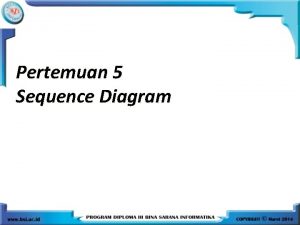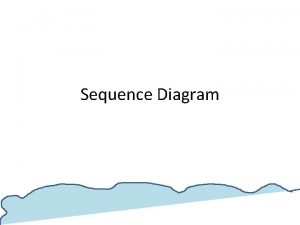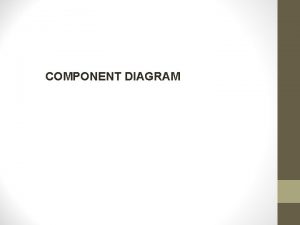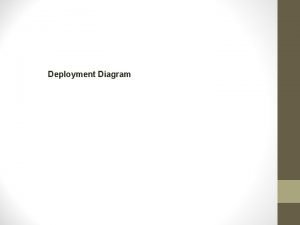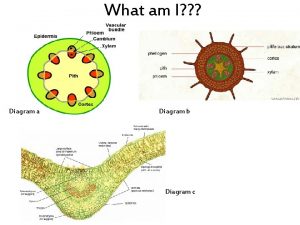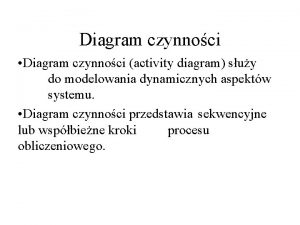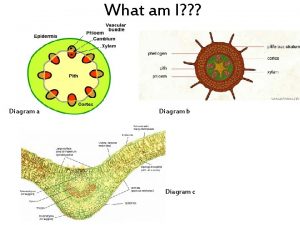Tuesday 1 Layer 4 in the diagram has


















































- Slides: 50

Tuesday 1. Layer 4 in the diagram has the greatest temperature and pressure. What part of the Earth is labeled layer 4? A. crust B. mantle C. outer core D. inner core 2. Ricardo has a sedimentary rock in his rock collection, which contains ancient snail fossils. Where did this rock MOST LIKELY form? A. in a volcano B. around a magma chamber C. on the ocean floor D. at the beach

Tuesday 3. Students want to identify a rock in a nearby field. Which of the following properties would be most useful in identifying the unknown rock? A. Luster B. Smell C. Mineral Content D. Specific Weight 4. Igneous rock forms from A. compaction and cementation of sediments. B. weathering and erosion of other rocks. C. magma deep within the Earth. D. evaporation of water from a pond.

Erosion & Deposition

Erosion & Deposition: Standard: S 6 E 5: Students will investigate the scientific view of how the earth's surface is formed. Element: d. Describe processes that change rocks and the surface of the earth. e. Explain the effects of physical processes (plate tectonics, erosion, deposition, volcanic eruption, gravity) on geological features.

Essential Questions: 1) 2) 3) 4) 5) What is erosion? What causes erosion? What is deposition? What causes deposition? What are the effects of erosion and deposition?

What is erosion? Erosion is a natural process of moving weathered rock and soil to another place. Erosion has a constant impact on Earth’s surface. Over millions of years, it wears down mountains by removing byproducts of weathering and depositing them elsewhere

Causes of Erosion: • Gravity constantly pulls material downward. • Water such as rainwater, water from melting snow, rivers, streams, and waves carry rock and soil particles. • Winds move small particles of dust through the air and larger particles of sand along the ground. • Ice, in the form of glaciers, transport rock and soil particles as they move downhill.

What is deposition? Deposition is a natural process of laying down or depositing sediment in new locations. Deposition occurs when: a) wind slows down or stops blowing. b) water slows down or stops moving. c) glaciers melt.

Gravity and Mass Movement Mass movement is the downhill movements of rock and soil. Gravity pulls material downward. A triggering event, such as heavy rain or an earthquake might loosen the rock and soil. As the material becomes looser, it gives way to the pull of gravity and moves downward.

Examples of Mass Wasting Landslide – a sudden fast movement of rock and soil Insane landslide in California https: //www. youtube. com/watc h? v=q. Eb. Ypts 0 Onw https: //www. youtube. com /watch? v=Y 6 vs_ln. Bqw. Y

Examples of Mass Wasting Rockfall – individual blocks of rock drop suddenly and fall freely down a mountainside Italian landslide: Huge boulders destroy buildings in South Tyrol https: //www. yout ube. com/watch? v =-5 Si. Qq. Sro. Iw http: //atlas. nrcan. gc. ca/site/english/maps/environment/naturalhazards/landslides/fig_2_land_rockfall. jpg

Examples of Mass Wasting Rockslide – a large mass of rock slides as a unit down a slope http: //data 2. collectionscanada. ca/ap/a/a 131072. jpg

Examples of Mass Wasting Mudflow – debris, or a mixture of rock, soil, and plants with a a large amount of water http: //www. fas. org/irp/imint/docs/rst/Sect 3/img 004. jpg www. uwsp. edu/geo/faculty/ritter/images/lithos. . .

Example of Mass Wasting Creep – slow downhill movement of rock and soil https: //www. youtube. com/watch? v=9 C 1 f. W 4 h. WLUM The diagram shows how the hillside slowly slips over time.

1. What landform is pictured? 2. What caused the landform?

https: // www. y outube. com/w atch? v =f. RUri croxcc http: //ejordan 0998. blogspot. com/2010/12/mass-movement-soil-creep. html

Mass wasting by an avalanche. It is similar to a landslide with ice and snow instead of rock.

cause Notes pg. 6

Water in all its forms causes erosion. Raindrops (especially in dry environments) create splash erosion that moves tiny particles of soil. Water collecting on the surface of the soil collects as it moves towards tiny rivulets and streams and creates sheet erosion. Streams and rivers move sediments. The faster water moves, the larger the objects it can pick up and transport.

Features caused by Water Erosion River Valley. V-shaped valley formed when water flows quickly down a steep slope

Features caused by Water Erosion https: //www. youtube. com/watch? v=e. Sh. Agvcns. P 0

The Grand Canyon

Features caused by Water Erosion Mesa As streams slowly cut through a plateau, they create flat-topped, rocky areas known as outliers. A large outlier is called a mesa. A tower-like outlier is called a butte. Buttes are tall, steep-sided towers of rock. Buttes are created by erosion. They were formerly part of flat, raised sections of land known as mesas or plateaus. Butte

Mesa



Features caused by Water Erosion Mesa When a river flows over more gently sloping land, it spreads out and erodes the land. The flat, wide areas of land along a river is a flood plain. https: //www. youtube. com/watch? v=q. Ez 4 Mi OVTMM

Features caused by Water Deposition Alluvial Fan Delta web. cortland. edu/gleasong/phgsg 3. html Alluvial Fan- landformed when sediment is deposited where a stream leaves a mountain range http: //www. geo. uu. nl/fg/palaeogeography/pictures/delta_evolution/delta. jpg Delta- landformed when sediment is deposited where a river flows into an ocean or lake

Features caused by Water Deposition southgakayakfishing. blogspot. com http: //www. fws. gov/midwest/Big. Muddy/images/jameson_sandbars. jpg River sandbars are formed when rivers curve and slow down, dropping sediments.

Features caused by Water Deposition Incoming waves deposit sand to form ocean sandbars – long ridges of sand parallel to the shore

Features caused by Water Deposition Mesa Flooding causes a river to rise above its banks and spread out over its flood plain. When the flood water finally retreats, it deposits sediment as new soil.

Features caused by Water Deposition Beach (shoreline) – landformed when waves deposit sediments along a coast or shore tripadvisor. com Two Ways To Make A Dune https: //www. youtube. com/watch? v=5 W 3_y 5_3 w 9 A notjustgeorgia. com

Features caused by Water Deposition http: //www. n-georgia. com/images/cost. Islnd. Web. jpg Jekyll Island, at 5, 700 acres, is the smallest of Georgia's barrier islands. The western side of Jekyll Island is fronted by Jekyll Creek and salt marsh, and the eastern edge of the island is defined by its beach and the Atlantic Ocean. http: //www. georgiaencyclopedia. org/nge/Multimedia. jsp? id=m-2086 Barrier Islands – storm waves pile up large amounts of sand above sea level forming a long narrow island parallel to the coast

1. 2. What landform is pictured? What caused the landform?

Erosion & Deposition

Ice Glaciers are large masses of ice that move over land. On a mountain, the weight of a heavy mass of ice causes it to flow downward, usually slowly. On flatter land, the ice spreads out as a sheet. As glaciers form, move, and melt away they shape landscapes.

Feature caused by Erosion by Glaciers Valley glaciers form in mountains and flow down through valleys. This is a picture of a glacier which carves out a U-shaped valley where it flows dragging rocks and boulders along the way.

Continental Ice Sheets A continental ice sheet or glacier (Greenland, below) is a vast expanse of ice which completely covers all underlying terrain. They form in mountainous or nonmountainous regions and spread outward in all directions. www. homepage. montana. edu/. . . /Continental. Ice. jpg

Features caused by Deposition by Glaciers deposit till (sediments) called moraines. Till is the mixture of sediments that a glacier deposits directly on the surface. Till can be clay, silt, sand, gravel, and boulders. http: //nsidc. org/glaciers/gallery/images/bylot_island_valley_large. jpg Glaciers leave depressions that become filled with water to form bowlshaped lakes, called kettle lakes. www. arctic. uoguelph. ca/. . . /pic 36. jpg

http: //capenews. net/blogs/latitude_somewhere/20 09/11/29/west-barnstabel-conservation-area/ Till deposited by glaciers. http: //faculty. unlv. edu/lachniet/Glaciers%20 and%20 ELA. html A striated and faceted limestone boulder in glacial till clearly demonstrates the presence of a former ice cap in the Sierra Cuchumatanes. (Western Gautamala) pubs. usgs. gov





Features caused by Water Erosion caves http: //www. arenal. net/tour/venado-caves/images/cave_tour_pic. jpg sinkholes http: //www. sewerhistory. org/images/mi/min_spd 1. jpg

Wind has the power to transport and deposit sediment. It can shape landforms, especially in dry regions and in areas that have few or no plants to hold soil in place. Wind can build up dunes, deposit layers of dust, or make a land surface as hard as pavement. The Work Of The Wind https: //www. youtube. com/w atch? v=VXDKLUA 4 lp. E

Features caused by Wind Erosion & Deposition Sand Dune - hill, mound, or ridge of windblown sand www. travelblog. org/. . . /tb_mui_ne_sand_dunes. jpg http: //ngm. nationalgeographic. com/2012/11/sand-dunes/steinmetz-photography#/01 -lut-desert-dasht-e-lut-iran-670. jpg

Features caused by Wind Erosion & Deposition Loess – deposits of dust or silt Desert Pavement – wind blows dust away, leaving only larger rocks http: //www. backyardnature. net/loess/vertbluf. jpg http: //pubs. usgs. gov/of/2004/1007/images/pavement 2. gif

These rocks have been blasted by wind and sand causing them to become rounded. WIND ABRASION

Bottom of Pg. 9 • The wind hits a boulder. • It deposits the sediment. • Wind removes sand other sediment from the ground by the process of erosion. • As the sediment piles up. • Piles of sediment cause sand dunes to forms.
 Pigmented layer and neural layer
Pigmented layer and neural layer Phases of deglutition
Phases of deglutition Secure socket layer and transport layer security
Secure socket layer and transport layer security Layer 6 presentation layer
Layer 6 presentation layer Secure socket layer and transport layer security
Secure socket layer and transport layer security Secure socket layer and transport layer security
Secure socket layer and transport layer security Secure socket layer and transport layer security
Secure socket layer and transport layer security Layer 2 e layer 3
Layer 2 e layer 3 Layer-by-layer assembly
Layer-by-layer assembly Layer 2 vs layer 3 bitstream
Layer 2 vs layer 3 bitstream Hát kết hợp bộ gõ cơ thể
Hát kết hợp bộ gõ cơ thể Frameset trong html5
Frameset trong html5 Bổ thể
Bổ thể Tỉ lệ cơ thể trẻ em
Tỉ lệ cơ thể trẻ em Gấu đi như thế nào
Gấu đi như thế nào Tư thế worm breton là gì
Tư thế worm breton là gì Hát lên người ơi alleluia
Hát lên người ơi alleluia Các môn thể thao bắt đầu bằng từ đua
Các môn thể thao bắt đầu bằng từ đua Thế nào là hệ số cao nhất
Thế nào là hệ số cao nhất Các châu lục và đại dương trên thế giới
Các châu lục và đại dương trên thế giới Công thức tính độ biến thiên đông lượng
Công thức tính độ biến thiên đông lượng Trời xanh đây là của chúng ta thể thơ
Trời xanh đây là của chúng ta thể thơ Mật thư tọa độ 5x5
Mật thư tọa độ 5x5 101012 bằng
101012 bằng độ dài liên kết
độ dài liên kết Các châu lục và đại dương trên thế giới
Các châu lục và đại dương trên thế giới Thơ thất ngôn tứ tuyệt đường luật
Thơ thất ngôn tứ tuyệt đường luật Quá trình desamine hóa có thể tạo ra
Quá trình desamine hóa có thể tạo ra Một số thể thơ truyền thống
Một số thể thơ truyền thống Cái miệng bé xinh thế chỉ nói điều hay thôi
Cái miệng bé xinh thế chỉ nói điều hay thôi Vẽ hình chiếu vuông góc của vật thể sau
Vẽ hình chiếu vuông góc của vật thể sau Thế nào là sự mỏi cơ
Thế nào là sự mỏi cơ đặc điểm cơ thể của người tối cổ
đặc điểm cơ thể của người tối cổ V cc
V cc Vẽ hình chiếu đứng bằng cạnh của vật thể
Vẽ hình chiếu đứng bằng cạnh của vật thể Vẽ hình chiếu vuông góc của vật thể sau
Vẽ hình chiếu vuông góc của vật thể sau Thẻ vin
Thẻ vin đại từ thay thế
đại từ thay thế điện thế nghỉ
điện thế nghỉ Tư thế ngồi viết
Tư thế ngồi viết Diễn thế sinh thái là
Diễn thế sinh thái là Dot
Dot Số nguyên tố là số gì
Số nguyên tố là số gì Tư thế ngồi viết
Tư thế ngồi viết Lời thề hippocrates
Lời thề hippocrates Thiếu nhi thế giới liên hoan
Thiếu nhi thế giới liên hoan ưu thế lai là gì
ưu thế lai là gì Hươu thường đẻ mỗi lứa mấy con
Hươu thường đẻ mỗi lứa mấy con Khi nào hổ mẹ dạy hổ con săn mồi
Khi nào hổ mẹ dạy hổ con săn mồi Sơ đồ cơ thể người
Sơ đồ cơ thể người Từ ngữ thể hiện lòng nhân hậu
Từ ngữ thể hiện lòng nhân hậu

























































